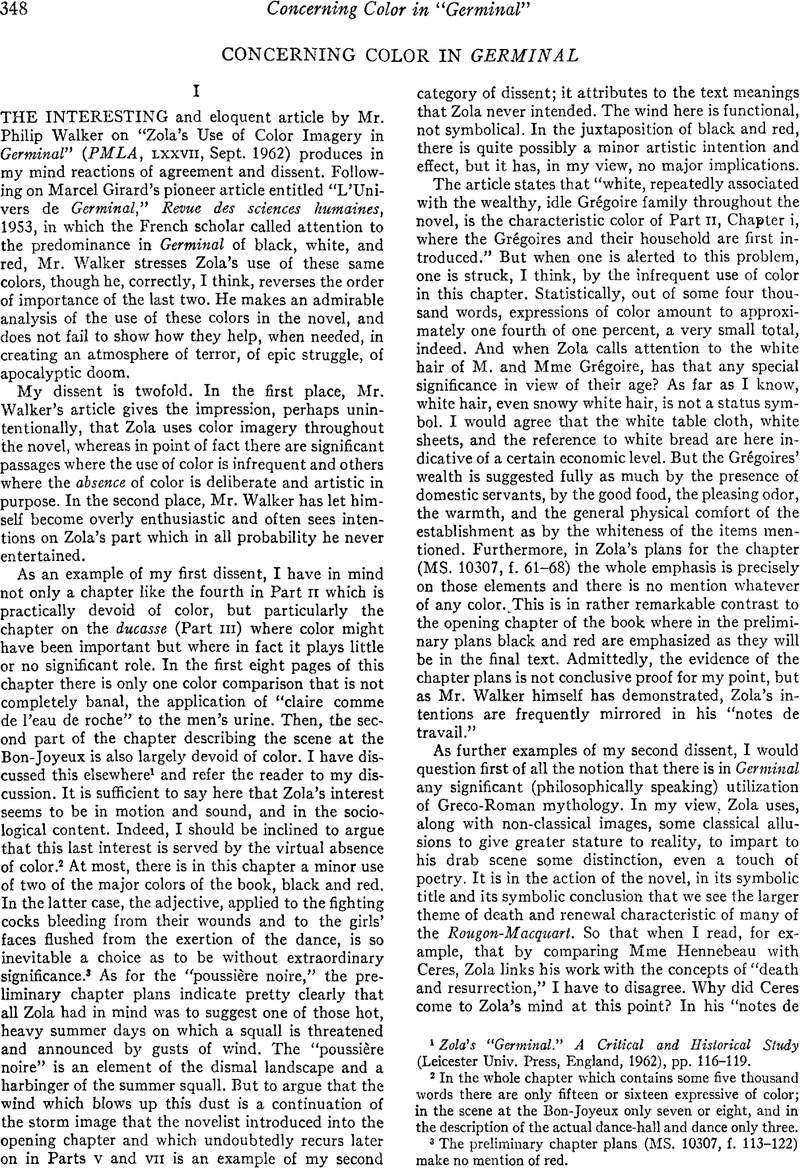No CrossRef data available.
Article contents
Concerning Color in “Germinal”
Published online by Cambridge University Press: 02 December 2020
Abstract

- Type
- Notes, Documents, And Critical Comment
- Information
- Copyright
- Copyright © Modern Language Association of America, 1964
References
1 Zola's “Germinal.” A Critical and Historical Study (Leicester Univ. Press, England, 1962), pp. 116–119.
2 In the whole chapter which contains some five thousand words there are only fifteen or sixteen expressive of color; in the scene at the Bon-Joyeux only seven or eight, and in the description of the actual dance-hall and dance only three.
3 The preliminary chapter plans (MS. 10307, f. 113–122) make no mention of red.
1 Cf. Zola's letter to Henry Céard on the nature of his “Mensonge” in Germinal: “Or—c'est ici que je m'abuse peut-être—je crois encore que je mens pour mon compte dans le sens de la vérité. J'ai l'hypertrophie du détail vrai, le saut dans les étoiles sur le tremplin de l'observation exacte. La vérité monte d'un coup d'aile jusqu'au symbole.” (Correspondance, Les Œuvres complètes, ii, ed. Maurice Le Blond, Paris: Bernouard, 1927–29, 637.)
2 See my article “Prophetic Myths in Zola,” PMLA, lxxiv (Sept. 1959), 444–452.
3 For example, Mr. Grant's statement that there is no mention of any color in Zola's plans for the chapter introducing the Grégoires (MS. 10307, foll. 61–68), is, of course, correct. In the original plans for the whole Rougon-Macquart series, however, Zola indicates that he plans to show “le noir pondéré avec le blanc.” (See the Bernouard edition of La Fortune des Rougon, p. 354.) In the Ebauche of Germinal, moreover, he tells himself, “Pour obtenir un gros effet, il faut que les oppositions soient nettes et poussées au summum de l'intensité possible” (MS. 10307, fol. 420). Associating white with the Grégoires after associating black with the Maheu family is quite possibly one way that might have occurred to him of heightening the essential contrast between his bourgeois and his proletarians.
4 I am grateful to Mr. Grant for pointing out in his book on Germinal, p. 129, Huysmans' admiration for Zola's use of black in a letter praising the “descente dans les puits, au milieu du noir dont vous êtes seul parvenu à faire une couleur, qui révèle une puissance de rendu vraiment unique à l'heure actuelle.”
1 At the same time it should be remembered, as Girard pointed out, that white, “le blanc terne,” is also used to indicate the physical weaknesses of the Maheus, their anemia, for example.


